
Opossums are members of the marsupial order Didelphimorphia endemic to the Americas. The largest order of marsupials in the Western Hemisphere, it comprises 126 species in 18 genera. Opossums originated in South America and entered North America in the Great American Interchange following the connection of North and South America.

The Orinoco is one of the longest rivers in South America at 2,250 kilometres (1,400 mi).

Tyler's mouse opossum is a South American marsupial of the family Didelphidae. It lives in rainforests of the Guiana Highlands of southern Venezuela at elevations between 1300 and 2200 m. The species has only been found on three isolated tepuis. All three of these locations are in protected areas.

The Arrau turtle, also known as the South American river turtle, giant South American turtle, giant Amazon River turtle, Arrau sideneck turtle, Amazon River turtle or simply the Arrau, is the largest of the side-neck turtles (Pleurodira) and the largest freshwater turtle in Latin America. The species primarily feeds on plant material and typically nests in large groups on beaches. Due to hunting of adults, collecting of their eggs, pollution, habitat loss, and dams, the Arrau turtle is seriously threatened.

The yellow-spotted Amazon river turtle, also known commonly as the yellow-headed sideneck turtle and the yellow-spotted river turtle, and locally as the taricaya, is one of the largest South American river turtles.

The gray four-eyed opossum is an opossum species from Central and South America, ranging from southern Mexico to Peru, Bolivia and southwestern Brazil, at altitudes from sea level to 1600 m, but generally below 1,000 metres (3,300 ft). Its habitats include primary, secondary and disturbed forest. It is one of many opossum species in the order Didelphimorphia and the family Didelphidae.
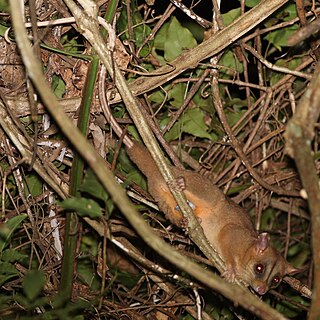
The bare-tailed woolly opossum is an opossum from South America. It was first described by Swedish zoologist Carl Linnaeus in 1758. The bare-tailed woolly opossum is characterized by a gray head, brown to gray coat, orange to gray underside and a partially naked tail. It is nocturnal and solitary; there is hardly any social interaction except between mother and juveniles and in mating pairs. The opossum constructs nests in tree cavities, and its litter size ranges from one to seven. Gestation lasts 25 days, and the juveniles exit the pouch after three months; weaning occurs a month later. The bare-tailed woolly opossum inhabits subtropical forests, rainforests, secondary forests, and plantations; its range extends from northern Venezuela to northeastern and southcentral Brazil. The IUCN classifies this opossum as least concern.

The brown-eared woolly opossum, also known as the western woolly opossum, is an opossum from South America. It was first described by German naturalist Ignaz von Olfers in 1818. The opossum is characterized by a brown to reddish brown coat and similarly colored limbs, yellow to orange underbelly, hairless, brown ears with a hint of pink, and a tail furred on the back for up to half of its length. The brown-eared woolly opossum is nocturnal, solitary and omnivorous. The IUCN lists it as least concern.
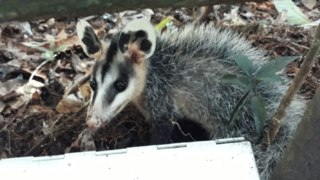
The Guianan white-eared opossum is an opossum species from South America. It is found in Brazil, Suriname, French Guiana and Venezuela.
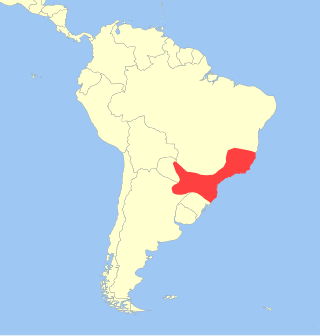
The southeastern four-eyed opossum is an opossum species native to South America. It is found in Atlantic Forest ecoregions, in Brazil, Paraguay and Argentina.

Anderson's four-eyed opossum is an opossum species from South America. It is found in Brazil, Colombia, Ecuador, Peru and Venezuela. Its dorsal fur is dark, with a black stripe, about 3–4 cm wide, going vertically down the midline of its back. Its dorsal fur is short, about 10 mm long. Its ventral fur is dark gray, but still distinctly lighter than the sides and dorsum. Its tail is furred for the first (approximately) 18% of its length, going from the base to the tip. Its species name "andersoni" was chosen to honor American scientific collector Malcolm Playfair Anderson.

The nine species in the genus Philander, commonly known as gray and black four-eyed opossums, are members of the order Didelphimorphia. Mature females have a well-developed marsupium. The tail appears to be hairless except for the proximal 5 or 6 cm, which has a few long hairs. The tail is slightly longer than the head-and-body length, and it is black for the proximal one half to two thirds of its length. The genus is closely related to Didelphis but the species of Philander are smaller than those of Didelphis. The genus formerly included Metachirus nudicaudatus, but this species lacks a pouch and so is now considered a separate genus. The common name comes from the white spots above the eyes, which can appear from a distance to be another set of eyes.

The wood sprite gracile opossum is a mammal. It is a species of opossum in the family Didelphidae. It is found in Colombia and Venezuela. Its natural habitat is subtropical or tropical moist lowland forests. It is threatened by habitat loss.
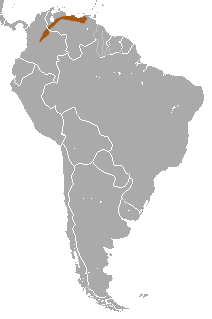
The northern gracile opossum is a species of opossum in the family Didelphidae. It is found in Colombia and Venezuela. G. marica naturally occurs in subtropical or tropical moist lowland forests.
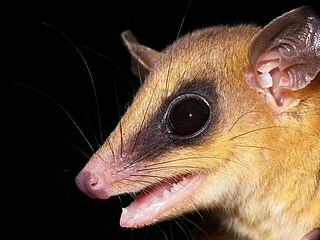
Robinson's mouse opossum is a species of opossum in the family Didelphidae. It is found in Belize, Colombia, Ecuador, Grenada, Honduras, Panama, Peru, Trinidad and Tobago, and Venezuela.
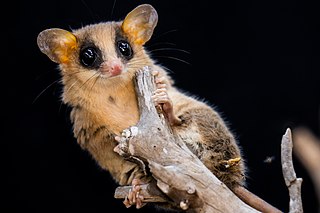
Gracilinanus is a genus of opossum in the family Didelphidae. It was separated from the genus Marmosa in 1989, and has since had the genera Cryptonanus, Chacodelphys, and Hyladelphys removed from it.

Mondolfi's four-eyed opossum is a South American species of opossum found in Colombia and Venezuela, first described in 2006. It inhabits foothills of the Cordillera de Mérida and those on the eastern side of the Cordillera Oriental at elevations from 50 to 800 m. Populations in the two ranges may represent distinct subspecies. It is named after the Venezuelan biologist Edgardo Mondolfi. It has short woolly fur with a pale cream-colored venter as well as large ears pigmented on only the distal half.
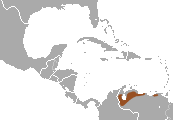
The hooded red-sided opossum is a South American opossum species of the family Didelphidae. Until recently, it was viewed as a subspecies of M. brevicaudata. It is found in Colombia and Venezuela at altitudes from sea level to 2250 m. It is a primarily nonarboreal resident of tropical rainforest, but has also been seen in areas under cultivation.

Reig's opossum is a South American opossum species of the family Didelphidae, discovered in 2004. It is named after Argentine biologist Osvaldo Reig (1929–1992). It was initially found in montane forest in Canaima National Park, Venezuela at an elevation of 1300 m in the Sierra de Lema. It is typically found between 1100 m and 2050 m on Mount Ayanganna.



















